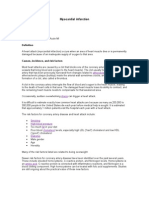Essential Thrombocythemia
Essential Thrombocythemia
Uploaded by
Jamal Anwar TahaCopyright:
Available Formats
Essential Thrombocythemia
Essential Thrombocythemia
Uploaded by
Jamal Anwar TahaOriginal Description:
Original Title
Copyright
Available Formats
Share this document
Did you find this document useful?
Is this content inappropriate?
Copyright:
Available Formats
Essential Thrombocythemia
Essential Thrombocythemia
Uploaded by
Jamal Anwar TahaCopyright:
Available Formats
Essential Thrombocythemia
Bone marrow disorder
From Mary Kugler, R.N., former About.com Guide Updated July 24, 2006
About.com Health's Disease and Condition content is reviewed by our Medical Review Board
See More About:bone marrow disordersblood cell disorders
Ads Asian Hospital Delhi NCR A NABH Super Speciality & North Ind Most Comprehensive Cancer Center www.aimsindia.co.in Cyberknife Cancer Turkey HIgh quality cyberknife cancer treatment at Anadolu Medical Center www.worldmedassist.com Medical treatment - India Top hospitals.1/4 of UK / S.Africa costs.Get free medical opinion now! www.aarexindia.com Rare Diseases Ads Blood Clot Symptoms Heart Attack Symptoms Blood Clots Symptoms Blood Clot Treatment Leg Blood Clot Symptoms A person with essential thrombocythemia (ET) has an excess amount of platelets in the blood due to a disorder of the bone marrow. A change in the bone marrow stem cell DNA causes the overproduction of platelet-forming cells in the bone marrow. What causes essential thrombocythemia to occur is not yet known. ET is one of the myeloproliferative disorders (MPD). There are an estimated 0.1 to 2.4 new cases of essential thrombocythemia per 100,000 people per year. ET may occur at any age but tends to be more common in adults. It affects both women and men of all ethnic backgrounds. Symptoms Many people with essential thrombocythemia have no symptoms. Others may have symptoms such as: skin problems such as redness, burning, or itching pain in the feet and hands a mildly enlarged spleen headache, dizziness, weight loss abnormal bleeding (rarely)
pregnancy complications abnormal blood clotting (most common problem) If a blood clot forms it may block blood flow to a part of the body. This may cause serious problems such as stroke (a blood clot in the brain) or heart attack (a blood clot in the heart). People who smoke or drink alcohol increase their risk of developing a blood clot. Diagnosis If an individual has no symptoms, essential thrombocythemia may be diagnosed from a blood test (platelet count) during a routine physical examination. An abnormally high number of platelets will be detected in the blood. The bone marrow may also be examined for the presence of excess platelets, and the spleen will be examined to see if it is enlarged. Other tests may be done to look for other disorders which may also cause a high number of platelets in the blood. Treatment Treatment depends on the level of platelets in the blood and the risk of clotting or bleeding complications. Plateletpheresis (removing platelets from the blood) may be used as an emergency treatment to quickly reduce an extremely high platelet level. Longerterm treatment may be observation of the individual's status through regular doctor visits if the risk for blood clots is low. Those with higher risk may be treated with medications such as hydroxyurea, anagrelide, or interferon alpha. Individuals with essential thrombocythemia usually have a normal lifespan with proper medical treatment. However, if a stroke, heart attack, or other serious complication occurs, the individual may have disability. Sources:[ - The Leukemia & Lymphoma Society. Essential or Primary Thrombocythemia - Arizona Telemedicine Program. Myeloproliferative Disorders Suggested Reading Other myeloproliferative disorders Elsewhere on the Web Leukemia & Lymphoma Society: Essential Thrombocythemia Friends of ET Research Related Articles Tips For Living with Low Platelets - What You Need to Know About Living wit... Blood Clot Prevention During Lung Cancer Treatment - Preventing
Blood Clots... Bone Marrow - What Is the Bone Marrow? Thrombocytopenia - What is Thrombocytopenia? Hematuria Blood in Your Urine--Blood in Men's Urine Hematuria--Risks of...
You might also like
- Bloor, The Functional Analysis of EnglishDocument332 pagesBloor, The Functional Analysis of Englishtranslatum96% (27)
- Universal GrammarDocument47 pagesUniversal GrammarJamal Anwar TahaNo ratings yet
- Who Diagnostic Criteria MyelofibrosisDocument2 pagesWho Diagnostic Criteria MyelofibrosisaymenNo ratings yet
- Blood Clotting DisordersDocument2 pagesBlood Clotting DisordersPopi Bunga RopikohNo ratings yet
- Platelet Defect and Clottimg Factor Defect-1Document21 pagesPlatelet Defect and Clottimg Factor Defect-1renusahu90886No ratings yet
- POLYCYTHEMIADocument48 pagesPOLYCYTHEMIAPoova RagavanNo ratings yet
- What Is ThrombocytosisDocument3 pagesWhat Is ThrombocytosisFred C. MirandaNo ratings yet
- Idiopathic Thrombocytopenic Purpura Johns Hopkins MedicineDocument5 pagesIdiopathic Thrombocytopenic Purpura Johns Hopkins MedicineRajesh Kanna A亗No ratings yet
- Peripheral Vascular DisordersDocument27 pagesPeripheral Vascular DisordersGadzikaNo ratings yet
- Health Encyclopedia - Diseases and ConditionsDocument4 pagesHealth Encyclopedia - Diseases and ConditionsThunder BoltNo ratings yet
- Massive Bleeding/Major Hemorrhage: DefinitionDocument6 pagesMassive Bleeding/Major Hemorrhage: DefinitionGerome Isaiah RabangNo ratings yet
- PIL - What Is Anaemia (A5)Document8 pagesPIL - What Is Anaemia (A5)Hassan ShahNo ratings yet
- Polycythemia Vera CompletedDocument5 pagesPolycythemia Vera CompletedSaro BalberanNo ratings yet
- Anemia Treatment & DiagnosisDocument7 pagesAnemia Treatment & Diagnosis5z4w285jbfNo ratings yet
- Causes: Polycythemia VeraDocument15 pagesCauses: Polycythemia VeraMaria VisitacionNo ratings yet
- Transfusion of Blood Products: Commonly Asked QuestionsDocument3 pagesTransfusion of Blood Products: Commonly Asked QuestionsBenny TrisaktyariNo ratings yet
- Aplastic Anemia and HomoeopathyDocument3 pagesAplastic Anemia and HomoeopathyDr. Rajneesh Kumar Sharma MD Hom100% (1)
- Coronary Artery DiseaseDocument9 pagesCoronary Artery DiseaseRantini Indrayani100% (1)
- Blood Clots Fact SheetDocument2 pagesBlood Clots Fact SheetAbdullah TheNo ratings yet
- A Case Analysis of Anemia2Document11 pagesA Case Analysis of Anemia2Recca Guirigay100% (1)
- Introduction To HaematologyDocument27 pagesIntroduction To HaematologyKesha NjobvuNo ratings yet
- 5hematologic DiseaseDocument40 pages5hematologic DiseaseAli SherNo ratings yet
- Biology: Investigatory Project OnDocument24 pagesBiology: Investigatory Project OnManish KarnaniNo ratings yet
- 'V 'V 'V 'V 'V 'V 'V 'V 'V 'V 'V 'V 'V 'V 'V 'V 'VDocument3 pages'V 'V 'V 'V 'V 'V 'V 'V 'V 'V 'V 'V 'V 'V 'V 'V 'VSunny DemandanteNo ratings yet
- Aplastic AnemiaDocument11 pagesAplastic AnemiaToni Shiraishi-Aque RuizNo ratings yet
- Idiopathic Thrombocytopenic PurperaDocument21 pagesIdiopathic Thrombocytopenic PurperaNader Smadi100% (3)
- Executive Health CheckupDocument27 pagesExecutive Health CheckupSubhashish DasNo ratings yet
- Cardiovascular Diseases: Presented By: Maliha Zulqarnain (31), Pernia Zuha (15), Maryam Rao (23), Minahil ZaheerDocument34 pagesCardiovascular Diseases: Presented By: Maliha Zulqarnain (31), Pernia Zuha (15), Maryam Rao (23), Minahil ZaheerTabeer fatimaNo ratings yet
- Blood Disorders 1701759600Document23 pagesBlood Disorders 1701759600Edwin leo ArockiadassNo ratings yet
- When To See A Doctor: CausesDocument3 pagesWhen To See A Doctor: CausesEric1201No ratings yet
- The Pathophysiology of Ischemic Strokes Is Widely Known. Ischemic Strokes Are TheDocument7 pagesThe Pathophysiology of Ischemic Strokes Is Widely Known. Ischemic Strokes Are Theprnczb13No ratings yet
- How Does Blood WorkDocument10 pagesHow Does Blood WorkFunnylyn CruzNo ratings yet
- Ischemic Stroke g6Document8 pagesIschemic Stroke g6Kistnah Cassandra GapolNo ratings yet
- What Is Chronic Kidney Disease (CKD) ?: Diabetes High Blood PressureDocument4 pagesWhat Is Chronic Kidney Disease (CKD) ?: Diabetes High Blood Pressureawana1991No ratings yet
- Platelet Count TestDocument11 pagesPlatelet Count TestmeddcoinfoNo ratings yet
- PSTHEDocument20 pagesPSTHEGamer ZionNo ratings yet
- Advantages of Blood DonationDocument6 pagesAdvantages of Blood DonationMAHESH KOUJALAGINo ratings yet
- Transient Ischemic Attack (TIA) : Heart Attack Peripheral Vascular Disease SmokingDocument3 pagesTransient Ischemic Attack (TIA) : Heart Attack Peripheral Vascular Disease SmokingPrincessdhay TandangNo ratings yet
- Patological Forming of Blood ClotsDocument18 pagesPatological Forming of Blood ClotsSamuil PetrovNo ratings yet
- Case Study (Heart Failure)Document18 pagesCase Study (Heart Failure)Maria Vanessa Lopez - BSN Level 3 A100% (1)
- Polycythemia Vera - Blood Disorders - MSD Manual Family Health VersionDocument4 pagesPolycythemia Vera - Blood Disorders - MSD Manual Family Health VersionShoaib BajwaNo ratings yet
- Haematopoiesis and Its DisordersDocument38 pagesHaematopoiesis and Its DisordersLaxman KannaNo ratings yet
- StrokeDocument25 pagesStrokeDede100% (1)
- Congestive Heart FailureDocument47 pagesCongestive Heart FailureRajesh Sharma100% (2)
- Neethus Part A 40 TestDocument244 pagesNeethus Part A 40 TestNadeeka GamageNo ratings yet
- HP Jan05 BleedDocument5 pagesHP Jan05 BleedSyahanim IsmailNo ratings yet
- Blood Disorders: Why Should I Know About Blood Conditions?Document1 pageBlood Disorders: Why Should I Know About Blood Conditions?Jeseyl Dapin CadaydayNo ratings yet
- TrobositopeniaDocument3 pagesTrobositopeniaFurqon SugandiNo ratings yet
- Platelet DisordersDocument6 pagesPlatelet DisordersMehr AliNo ratings yet
- Pathology The Heart of Modern Healthcare MS PowerpointDocument79 pagesPathology The Heart of Modern Healthcare MS PowerpointRicardo HernadezNo ratings yet
- Arterial ThrombosisDocument4 pagesArterial ThrombosisFaraida Jilzani ArsadNo ratings yet
- Blood Tests Types Analysis and Meaning PDFDocument25 pagesBlood Tests Types Analysis and Meaning PDFRandy Dookheran86% (7)
- Bleeding Disorders 2Document16 pagesBleeding Disorders 2Bijay SharmaNo ratings yet
- Blood Transfusion PDFDocument20 pagesBlood Transfusion PDFalaamorsyNo ratings yet
- Blood Diseases تقرير امراض الدمDocument7 pagesBlood Diseases تقرير امراض الدمBedo IbrahimNo ratings yet
- Polycythemi A: Presented By: Palaran, Nina Mae CDocument16 pagesPolycythemi A: Presented By: Palaran, Nina Mae CJichutreasureNo ratings yet
- Immune Thrombocytopenia (ITP) - Blood Disorders - MSD Family Health Version ManuDocument5 pagesImmune Thrombocytopenia (ITP) - Blood Disorders - MSD Family Health Version ManuShoaib BajwaNo ratings yet
- Plantelet DisordersDocument36 pagesPlantelet DisordersEthan Merza EctoleNo ratings yet
- What Is A Blood Transfusion?: Important Information About BloodDocument8 pagesWhat Is A Blood Transfusion?: Important Information About BloodAdrian ArdamilNo ratings yet
- Cindy M. Minasalbas BSN-401 Immunodeficiency Disorders: How The Test Is PerformedDocument17 pagesCindy M. Minasalbas BSN-401 Immunodeficiency Disorders: How The Test Is PerformedAlvin Binoy LazarraNo ratings yet
- Myocardial Infarction: Alternative NamesDocument5 pagesMyocardial Infarction: Alternative NamesKhalid Mahmud ArifinNo ratings yet
- High Platelets, (Thrombocythemia) A Simple Guide To The Condition, Diagnosis, Treatment And Related ConditionsFrom EverandHigh Platelets, (Thrombocythemia) A Simple Guide To The Condition, Diagnosis, Treatment And Related ConditionsNo ratings yet
- 2014 SUSI - Scholars - Application FormDocument5 pages2014 SUSI - Scholars - Application FormJamal Anwar TahaNo ratings yet
- Translation EquivalenceDocument6 pagesTranslation EquivalenceJamal Anwar TahaNo ratings yet
- The Amazing Collection of Holy QuranDocument3 pagesThe Amazing Collection of Holy QuranJamal Anwar TahaNo ratings yet
- Signs of The HourDocument34 pagesSigns of The HourJamal Anwar TahaNo ratings yet
- Signs of The HourDocument34 pagesSigns of The HourJamal Anwar TahaNo ratings yet
- Grammaticalisation in EnglishDocument2 pagesGrammaticalisation in EnglishJamal Anwar TahaNo ratings yet
- Afalanga CVDocument17 pagesAfalanga CVBagasNo ratings yet
- Genderen Et Al-1997-British Journal of HaematologyDocument6 pagesGenderen Et Al-1997-British Journal of HaematologyJicko Street HooligansNo ratings yet
- Trombocytosis Essential PDFDocument5 pagesTrombocytosis Essential PDFKerin ArdyNo ratings yet
- HepatosplenomegalyDocument52 pagesHepatosplenomegalySundar NatarajanNo ratings yet
- Essential ThrombocytosisDocument5 pagesEssential ThrombocytosisDina MaulidaNo ratings yet








































































